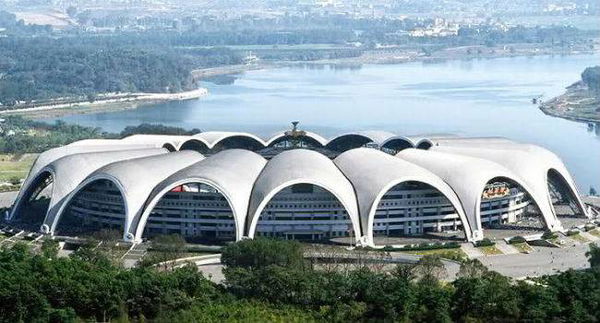

Football is one of the world?s biggest and most popular sports. According to the 2016 FIFA Big Count, there are 290 million soccer players in the world, 300 million when referees and match officials are?included. This has led to stadiums becoming increasingly sophisticated and bigger.
Barcelona has already decided to?extend the Camp Nou?stadium to?a capacity of 105,000.?Real Madrid and Madrid City Council have reached an agreement over the ?400 million renovation of the Santiago Bernabeu.?Chelsea has also secured?permission for Stamford Bridge stadium to?expand the ground?s capacity to 60,000 seats.

via Imago
Construction of a spectacular outer-skin which will engulf the stadium.

via Imago
Japanese firm Nikken Sekkei and Pascual i Ausi? Arquitectes will?design the new Camp Nou.
ADVERTISEMENT
Article continues below this ad
We look at the?biggest football stadiums in the world?(by capacity) :
1) Rungrado May Day Stadium – Pyongyang, North Korea.
Capacity: 150,000
Home team: North Korea National Team
This North Korean stadium is not just the largest football stadium in the world, but the largest stadium in the world excluding those built for auto-racing.?Predominantly it is used for ‘arirang’ performances (also known as the Mass Games) and state events, but the North Korea national football team still plays some of its matches at the stadium.

via Imago
Rungrado May Stadium of North Korea is the largest football stadium in the world.

via Imago
Rungrado May Day Stadium.
2. The Salt Lake Stadium aka Yuva Bharati Krirangan in Kolkata, India
Capacity :??120,000
Home team: India National Football Team, Mohun Bagan AC, Southern Samity, Mohammedan SC, East Bengal FC, Atletico de Kolkata
Also known as the Yuva Bharati Krirangan and built in 1984, the Salt Lake Stadium in Kolkata?is a multi-sports arena with football being the major sport. It is home to various Indian football clubs like?East Bengal?and?Mohun Bagan?and often hosts the national team?s fixtures.
The stadium?also boasts of being the stadium where the?farewell match of German legend Oliver Kahn?was played.

via Imago
In 2008 it was the site of Oliver Kahn farewell, when Bayern faced Mohun Bagan in a friendly.

via Imago
Salt Lake Stadium, Vivekananda Yuba Bharati Krirangan is a multi-purpose stadium in Bidhannagar, Kolkata, West Bengal. It is the largest stadium in India and second-largest in the world.
3. Bukit Jalil National Stadium in Kuala Lumpur, Malaysia
Capacity : 110,000
Home Team?:?Malaysia National Football Team
The stadium was constructed for the Commonwealth Games in 1998.?Situated in Kuala Lumpur, the stadium is owned by the Malaysian government. While initially used for athletics, the main usage of the stadium now is by the Malaysian national team. A number of domestic football fixtures such as the Malaysian FA Cup final also take place at the stadium which has a reputation for being one of the most structurally impressive stadium ever built.

via Imago
The stadium was built on 1 January 1995 to host the 1998 Commonwealth Games.

via Imago
National Stadium, Bukit Jalil has been host to other important events besides football matches.
4. The Azteca Stadium Mexico City, Mexico
Capacity : 105,064
Home Team :?Mexican national team and Club Am?rica football club.
First opened in 1966, the Azteca was the venue of Diego Maradona’s ‘Hand of God’ goal and then his sublime second against England at the 1986 World Cup.?The Estadio Azteca of Mexico City is the largest stadium in the world used solely for football. It is also a stadium steeped in history. The stadium has twice hosted the World Cup final in both 1970 and 1986, the only stadium to hold that honour.

via Imago
The Estadio Azteca (Spanish pronunciation: [es?ta?jo as?teka]) is a football stadium located in the suburb of Santa ?rsula in Mexico City, Mexico.

via Imago
Regarded as one of the most famous and iconic football stadiums in the world, it is the first to have hosted two FIFA World Cup Finals.
5. The Camp Nou in Barcelona, Spain
Capacity :?99,345
ADVERTISEMENT
Article continues below this ad
Home Team : FC Barcelona
Camp Nou is one of the largest and beautiful football stadiums in the world. It is situated in Barcelona,?Spain. Since 1957, this stadium has been the home of Barcelona FC. It has a seating capacity of 99,354 and the largest football stadium in Europe. It has hosted many popular sporting events such as the 1992 Olympics, and finals of the UEFA Champion Leagues. The stadium took a span of three years to be constructed at a cost of around 288 million pesetas.
ADVERTISEMENT
Article continues below this ad

via Imago
Camp Nou (Catalan pronunciation: [kam?n?w], “new field”, often incorrectly referred to as the “Nou Camp” in English) is a football stadium in Barcelona, Catalonia, Spain. It has been the home of FC Barcelona since its completion in 1957.

via Imago
With a seating capacity of 99,354,[4] it is the largest stadium in Spain by capacity. It is also the largest stadium in Europe
ADVERTISEMENT
ADVERTISEMENT
ADVERTISEMENT
ADVERTISEMENT

